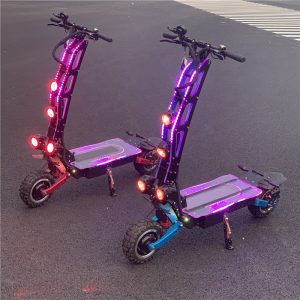The electric scooter industry has experienced significant growth in the past few years, with more people looking for eco-friendly and cost-effective modes of transportation. The demand for longer range electric scooters has risen significantly, as users seek a vehicle that can travel greater distances without the need for frequent recharging. This article will explore the world of 90-120km long range electric scooters, their features, benefits, and how they are revolutionizing personal mobility.
Understanding Long Range Electric Scooters
Electric scooters, also known as e-scooters, are motorized two-wheeled vehicles that operate independently without human intervention. They are powered by a battery, which is recharged through a charging station or an external power source like a wall outlet or solar panel. Electric scooters offer several advantages over traditional petrol-powered vehicles, including zero emissions, ease of use, and reduced operating costs.
The growing awareness of environmental issues and the increasing availability of charging infrastructure have led to a surge in the adoption of electric scooters worldwide. However, many users still face limitations due to the limited range of these vehicles. The average range of an electric scooter is between 40km and 70km, which means that users often have to recharge their vehicles after short trips. This limitation has prompted manufacturers to develop longer-range electric scooters that can travel up to 90km or even more.
Features and Benefits of 90-120km Long Range Electric Scooters
Long range electric scooters boast several unique features and benefits that set them apart from conventional scooters. Some of the key features include:
- Higher Battery Capacity: To achieve a longer range, electric scooters require higher battery capacity. Manufacturers are continually improving battery technology to provide larger batteries that can store more energy. The increased battery capacity allows riders to travel longer distances on a single charge, reducing the need for frequent charging stops.
- Advanced Charging Technology: Long range electric scooters often come with faster charging capabilities, allowing riders to replenish their batteries in less time. Many models now support rapid charging technologies, such as DC fast charging, which can charge a battery from 0% to 80% in just 30 minutes or less.
- Advanced Power Management Systems: To extend the driving distance further, manufacturers integrate advanced power management systems into their vehicles. These systems optimize the battery’s performance by managing power distribution to the motor and reducing energy wastage. Features like engine braking and regenerative breaking help to improve fuel efficiency and reduce wear on the motor and battery.
- Lightweight Construction: Long range electric scooters are designed with lightweight materials to reduce the overall weight of the vehicle. Heavyweight components, such as batteries and motors, can significantly impact the range of an electric scooter. By using lightweight materials, manufacturers can design vehicles that offer a greater range while maintaining portability and ease of use.
- Advanced Motor Systems: Long range electric scooters often feature high-torque motors capable of producing significant power output. These motors enable the vehicle to accelerate quickly and maintain speed over longer distances. Additionally, advanced motor designs like brushless DC motors tend to be more efficient and reliable than traditional motors.
- Ergonomic Design: To ensure rider comfort and convenience, many long range electric scooters come with ergonomic designs that prioritize passenger well-being.




